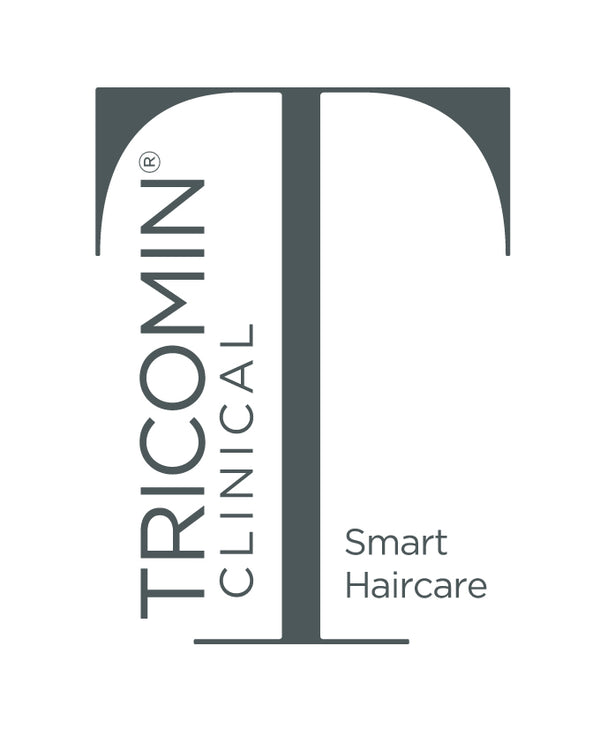Research + Innovation
Hair loss usually develops gradually in both men and women. While the average scalp contains about 100,000 hairs, roughly 100 hairs are lost from the head every day. Each individual hair shaft survives for an average of four to five years, during which time it grows about half an inch a month. Sometime in its 5th year, the hair falls out and is replaced within 6 months by a new one.
Both men and women tend to lose hair thickness and amount as they age. Inherited or “pattern baldness,” both male and female, is the most common type of hair loss. Typical male pattern baldness involves a receding hairline and thinning around the crown with eventual bald spots. In males, the male pattern baldness is more commonly termed androgenetic alopecia for the involvement of the enzyme steroid 5α-Reductase in the conversion of testosterone to dihydrotestosterone in the hair follicles. This conversion results in progressive shortening of the growth cycle of the hair follicles, miniaturization of the follicles, and resultant hair loss.
Baldness is not usually caused by a disease, but is related to aging, heredity and testosterone metabolism. In addition to the common male and female patterns from a combination of these factors, other possible causes of hair loss include chemotherapy and radiation therapy and certain autoimmune diseases.
Copper Peptides
Copper is essential to vital cellular and enzyme processes required for human health and is the third most abundant trace metal in the body, after iron and zinc. Since the 1830s, copper has been known to be an essential nutrient. Copper plays a key role in several of the body’s essential enzyme systems needed for tissue repair, hair growth and other biological responses. These copper-based enzyme systems allow tissue to repair itself, blood vessels to form, wounds to close and inflammation to decrease. Copper is now known to be critical to the normal repair and healing process in all tissue, including connective tissues that comprise human skin, internal organs and bones.
Skin and scalp health, dermal wound healing, and general soft tissue repair requires many of the same biological processes such as reconstitution of an extracellular matrix and increased blood from (angiogenesis). Copper is utilized by essentially every cell and organ; resulting in the formation of important copper-dependent enzymes.
In numerous studies, copper peptides have been shown to promote new blood vessel growth, enhance the expression of growth factors, activate matrix metalloproteases and stimulate the formation of new collagen, elastin and glycosaminoglycan components of tissue to accelerate the repair process.
The extracellular matrix is important to the health of the hair follicle as it provides structural integrity and components, as well as a nutrient supply.
Hair Growth
Typically, hair on the human scalp grows about 0.3 to 0.4 mm/day or about 6 inches per year. At any given time, a random number of hairs will be in various stages of growth and shedding. There are three stages of hair growth: catagen, telogen, and anagen.
Catagen - the transitional phase and 3% of all hairs are in this phase at any time. This phase lasts for about 2-3 weeks for scalp hair during which time hair growth stops.
Telogen - the resting phase of the hair cycle and accounts for 10-15% of all hairs. This phase lasts for about 100 days for hairs on the scalp and much longer for hairs on the eyebrow, eyelash, arm and leg. During this phase the hair follicle is completely at rest.
Anagen - the active phase of the hair. The cells in the root of the hair are dividing rapidly. A new hair is formed and pushes the old hair up the follicle and eventually out. During this phase the hair grows about 1 cm every 28 days. Scalp hair stays in this active phase of growth for 2-6 years. The length of the hair depends on the length of the anagen growth phase. The hair on the arms, legs, eyelashes, and eyebrows has a very short active growth phase of about 30-45 days which explains why they are so much shorter than scalp hair.
Other important aspects of hair growth, and more importantly of hair loss, are the types of hair produced by growing hair follicles. Large hair follicles, typical of normal hair growth produce what is called terminal hairs; large diameter, long, pigmented hairs. Small hair follicles such as those on the body or face or scalp, under the influence of dehydrotestosterone, produce vellus hair; small diameter, short, lightly pigmented hairs.
Studies with Copper Peptides
A number of peptide copper complexes have been demonstrated to have stimulatory effects of the growth of hair in experimental models and in preliminary studies with small numbers of human volunteers. These copper peptide complexes were potent stimulators of the transition of telogen follicles to growing anagen follicles when used intradermally or by topical application in model studies.
In the human volunteers, the peptide copper complex treatment after six months led to an increase in anagen hair density of the scalp.

